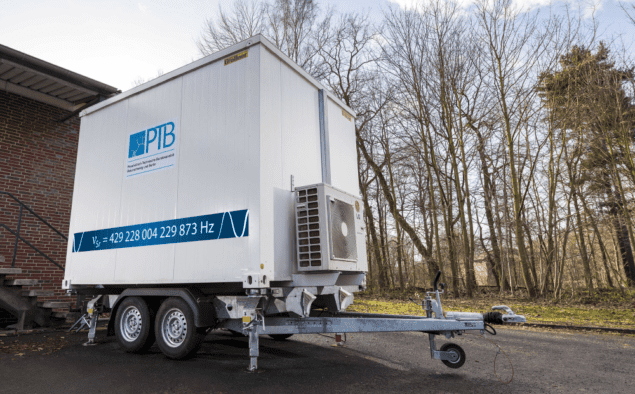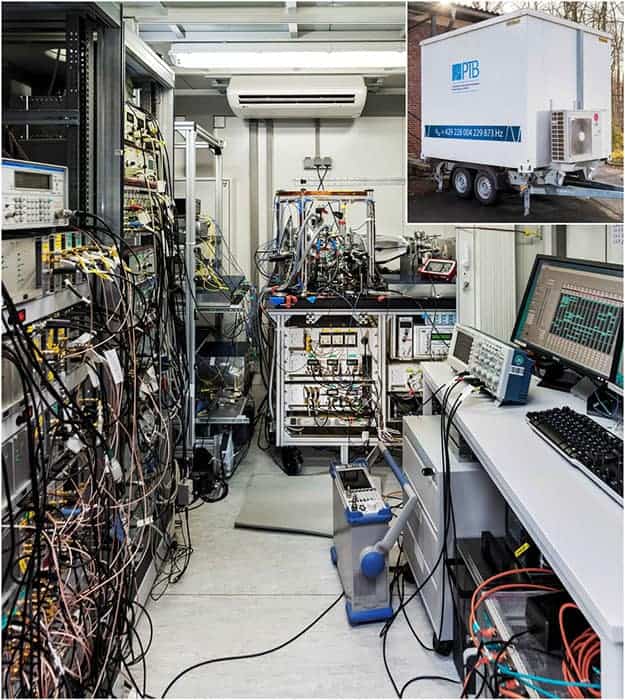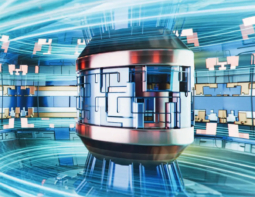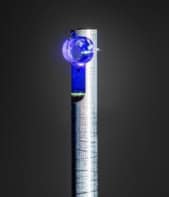
A portable optical lattice clock on a trailer has been used to measure elevation deep inside a mountain near the France-Italy border. Although this elevation measurement is not as precise as conventional geodetic methods, the experiment marks an important advance in optical clock technology.
Optical lattice clocks are the most precise timekeepers ever developed, losing about 1 s every 10 billion years. The clocks are extremely sensitive to changes in their local environment, and until now have only been operated in laboratories under highly-controlled conditions. However, a portable optical lattice clock would allow researchers to exploit the device’s remarkable precision to make a wide range of measurements from geodesy (measuring the shape of the Earth) to putting physical theories to the test.
“It’s the first time anybody has operated one of these lattice clocks outside of the laboratory,” explains Andrew Ludlow of the National Institute of Standards and Technology in the US, who was not involved in the research. “It’s kind of a big deal because these are generally pretty complicated laboratory experiments.”
Running behind
The elevation measurement was made by a Europe-based team led by Christian Lisdat of PTB (Germany’s national metrology laboratory) and relies on principles of Einstein’s general theory relativity. The idea is that a clock in a larger gravitational potential – in this case closer to sea level – will tick slower than a clock in a lower potential at a higher elevation. By comparing the time kept by clocks at separate locations, the difference in elevation of the two places can be deduced.
The team towed their portable clock to the Modane Underground Laboratory, which is in the French Alps and accessed via the Fréjus road tunnel between France and Italy. They then compared the time it kept in Modane to another clock at a laboratory down the road in Turin, Italy. They found that the Modane-based clock ran about 0.2 ns faster per day.
Working with geodesy experts, they could determine Modane’s elevation with an uncertainty about 20 m. This is by no means a state-of-the-art measurement of elevation – but rather a proof-of-principle exercise – and the team hopes to reduce the uncertainty of future measurements to several centimetres.
Localized measurements
Optical-clock geodesy could offer several technical advantages over conventional methods such as satellite imaging. Clocks have much better spatial resolution, for example. “The atoms in the clock are tiny and very well-localized, so we measure exactly at that spot,” says Lisdat. Clock data can also be used in conjunction with other methods to confirm measurements. Measurements using a portable clock could be useful, for example, for monitoring sea level rise due to climate change.
Lisdat’s team used a clock that employs strontium atoms that are trapped by laser beams. When excited with light at the correct frequency, the atoms emit electromagnetic waves that cycle at over a hundred trillion times a second, and the clock counts the cycles to keep time. The cycles remain constant as long as the atoms are trapped in a vacuum and held at a constant, ultracold temperature.
“We have about six different laser systems at different wavelengths that have to be guided to the right spot in the vacuum chamber to make the experiment work,” explains Lisdat. These lasers need to emit light consistently at strontium’s precise transition frequencies and the optical system that delivers the light must remain aligned to an exquisite degree of precision.
“One and a half PhD theses”
These requirements are difficult to meet in a laboratory, and to create their portable clock, the team also had to miniaturize its components and make them robust enough to work in different environments. Lisdat says this took “one and a half PhD theses, plus a lot of knowledge of building clocks from more PhD theses.” The team also relied on several decades of institutional experience building other atomic clocks, such as the caesium microwave clock that currently defines the second.

Optical clocks hit the road
For its first run at Modane, the clock worked inconsistently and the team often had to tinker with and re-align its components. As a result, the physicists are now working on making their clock more reliable and more accurate.
Beyond geodesy, portable optical lattice clocks could have a variety of other applications, says Ludlow. As well as providing a precise definition of time, physicists could use portable clocks to test general relativity and look for possible variations in fundamental constants that could point to the nature dark matter or extensions to the Standard Model of particle physics.
The research is described in Nature Physics.



